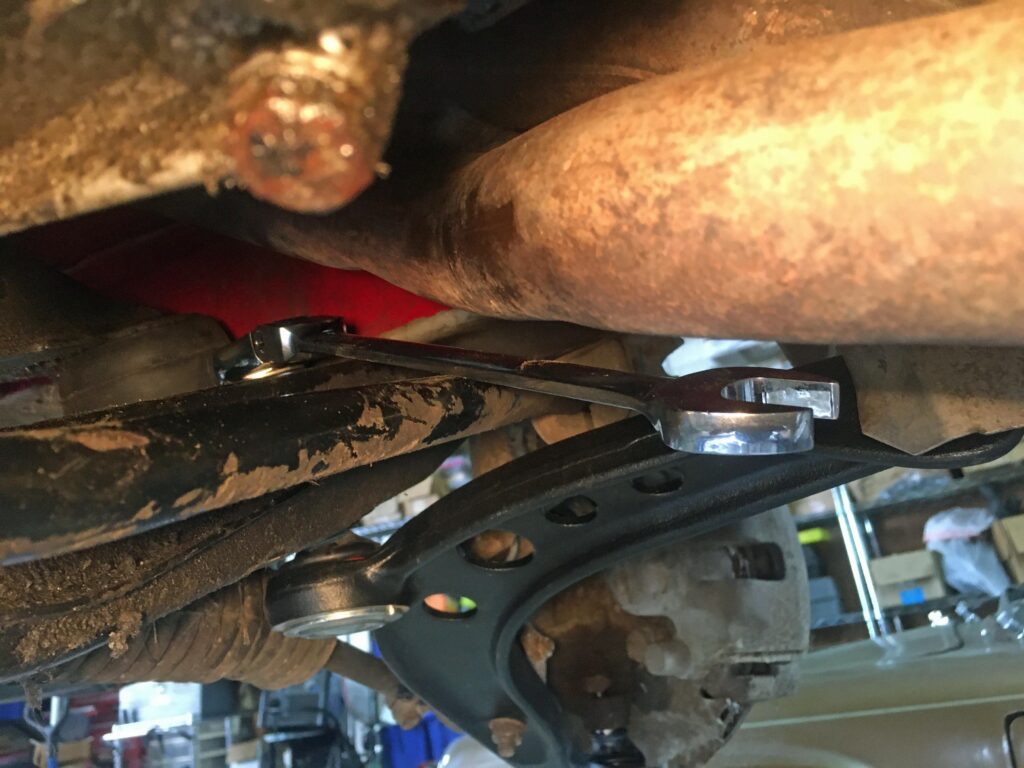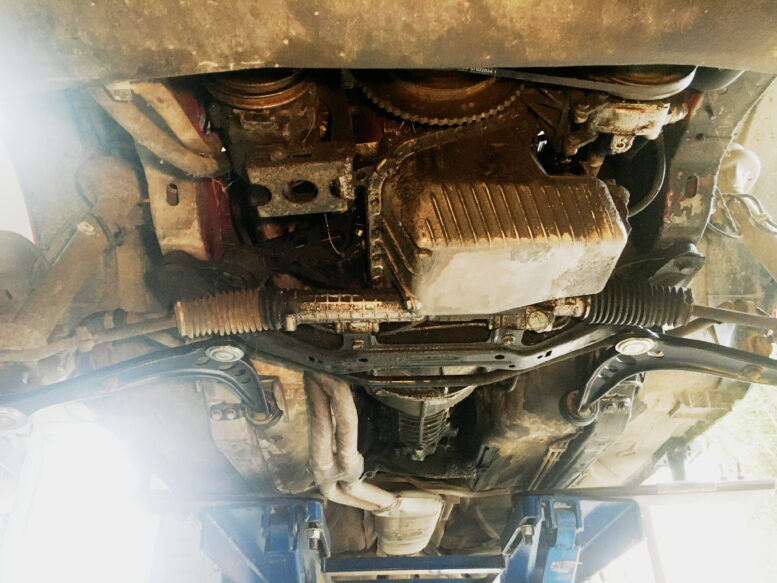Last week, I took the FrankenThirty to get inspected, and came back instead with The Scarlet R(ejection) Of Shame due to a worn-out left outer ball joint (the right one also showed a little play). There was zero question that the car could use a full steering-and-suspension refresh, as those systems, like nearly all others on the car, hadn’t seen any maintenance in, well, ever. There was also zero question that the car wasn’t going to get anything from me other than the bare minimum to pass inspection and be made drivable so I could see what it really was. So I approached the repair with my mental ice axe and crampons needed to avoid the twin slippery slopes of “while you’re in there” and “do it once, to it right.”
My first reaction was “It needs a left outer ball joint, fine—I’ll replace the left outer ball joint.” I jumped on RockAuto and found that I could get one outer ball joint, shipped, for about eighteen bucks. Great. I put it into the cart. Then I read up on the repair. It had been decades since I’d worked on a car with the odd sickle-cell-shaped lower control arms and “lollipop” bushings that the E30 has. I was reminded that the ball joint are replaceable in name only, and that anyone in their right mind simply replaces the entire control arm with one that comes with new outer and inner ball joints. I looked again on RockAuto and found a set of TRW lower control arms on closeout for $67 for the pair, shipped. Perfect. The cost was so low and the time and effort savings was so high that I was willing to rappel down that first icy flare of the slippery slope, but no further.
While waiting for the new lower control arms to arrive, I began pulling the old ones out. One 19mm nut and a ball joint separator on the outer ball joint, one 22mm nut and a pickle fork on the inner, and two 17mm bolts holding on the lollipop. Simple, right? Yes, except that the 22mm nut for the inner ball joint is located up above the front subframe. It’s easy enough to reach, but difficult to get leverage and an arc of rotation on. Alternating between using a breaker bar and a wrench with pipe on the end, I was able to crack the Nyloc nut on both sides and make a hundred small rotations of the wrench to get it off. When I was done, I walked over to my laptop and put an inexpensive gear-wrench-style 22mm ratchet wrench with a flexible head on order, as I now knew that it would make installation much easier.

One of several tools used to get the nut securing the inner ball joint off.
With the control arms on the garage floor, I needed to pull the lollipops and their rubber bushings off the ends so I could reuse them. There was nothing obviously bad about them, and remember: No. Slippery. Slope. I beat on them a bit with a rubber mallet, but they wouldn’t budge. A friend recommended that I heat them up a bit with a torch, but I didn’t want to damage them. I hunted around in my puller draw and found only traditional armed pullers that gripped the circumference of the metal lollipop, thus threatening to rip the rubber bushing. Then I remembered that, during the pandemic, I’d bought a huge OTC Hub Grappler kit from a guy out in Springfield to deal with the rear wheel bearings on the Winnebago Rialta. I unearthed it in the back of the garage, and sure enough, it had a piece with sliding arms that could be positioned directly on the rubber on the center as opposed to on the edge. A few minutes per side and I had them off. I love it when you buy something like this and it pays dividends years later.

The Hub Grappler to the rescue.
When the new lower control arms arrived, I carefully test-fit the left and right lollipops and bushings and held the assemblies under the car to be sure I had them on the correct sides, then soaped up the tips of the new LCAs and twisted the lollipops in place.

Old and new.
The flex-head 22mm ratcheting wrench also arrived. Even if this is the only time I ever use it, it was well worth the seventeen bucks, as it made short work of spinning on the Nyloc nuts on the inner ball joints above the subframe.

Very handy for $17.

Talk about “the right tool for the right job.”
With both lower control arms done, I took the FrankenThirty down off the lift, and the following morning, drove it straight to the inspection station, where it passed without incident.

Booya!
The now-legal car was ready for its first real drive. I’d driven it around the block a few times, and then to the gas station and inspection station and back, but I had no idea how it would behave on the highway. Although it was a running vehicle when I bought it (the car was wearing a 2022 inspection sticker, I gave it a 30-second test drive, then drove it onto the U-Haul trailer), the CarFax showed that the car’s use had plummeted after 2017, with its annual mileage falling from hundreds to dozens. After 2020, it’s likely it was only driven to annual inspections, and likely wasn’t driven at all the past two years.
And?
It was surprisingly, perhaps amazingly, good—no stumbling, no pulling, no driveline vibration, no wheel shimmy (which was a specific concern since I was reusing the LCA bushings), and felt great both around town as well as at 75mph on the highway. It’s long been my experience that BMWs like to be revived, and I had the unmistakable feeling that the car was happy it was being used, and—dare I say it?—enjoyed. I opened up all the climate-control vents, and while the rodent scent is certainly still detectable, to me it’s largely within the usual “old car smell” envelope.

The car feels like Flounder in Animal House going “Oh boy, is this great!”
So. We’re over the big hump. The FrankenThirty is legal, running well, and putting out a good vibe. The month since I bought it has been quite a roller coaster, going from being thrilled to pay five grand for a rust-free running driving 325is, to a revised OH GOD IT’S A FRANKEN-CAR, to “actually, it’s not that bad,” to feeling a bond. All-in—purchase, sales tax, parts—the tally is six grand, so I’m feeling a bit more relaxed about cost containment
I’ve got a laundry list of small things to deal with that’ll make it feel more whole (seized passenger-side window motor, the non-functional and partially-ajar sunroof, getting the glovebox back in, sourcing a used trunk carpet piece to cover the spare tire), but this is a good place to be. I’d consider driving the car to Vintage at Saratoga in October, but Maire Anne and I are seeing old friends in Vermont that weekend. And, to answer the obvious question, I’d consider driving it on that trip, but if it’s cold out and I have to roll up the windows and turn on the heat, my wife’s exquisitely sensitive sense of smell would not approve. She’s the most wonderful spouse in the world, and I’m not an idiot.
—Rob Siegel
____________________________________
Rob’s newest book, The Best of The Hack Mechanic, is available here on Amazon, as are his seven other books. Signed copies can be ordered directly from Rob here.





















